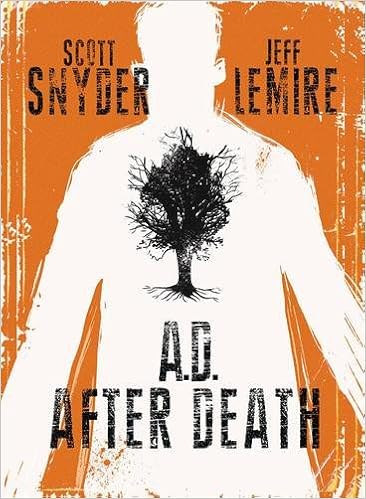A.D. (After Death)
Ooooh, it's a review about not a game!
Maybe I shouldn't sound that excited. This isn't an excitement book.
Jonah's a thief. Lots of people are thieves, but Jonah's a good thief. He strategizes on the Internet with other thieves, and people who give the thieves ideas of what to steal. Eventually he meets one of those idea people (Head of Table), who asks him to steal something very special: a forty-year-old woman with a disease that has kept her physiologically a child.
Yes, it's kidnapping. They don't call it that. It's just stealing something else to them.
The book jumps between Jonah's memories of the past and the book's present day, which is over eight centuries in the future, since the cure for death was found. Jonah's reached a point where he blames himself; he was, after all, instrumental in acquiring the basis for that research via the aforementioned kidnapping. Why would he blame himself for it, you may ask? Is this another story where immortality is found to be something unwanted, filled with people tired of life but too scared to finally off themselves?
I'll leave that question unanswered, in an effort not to spoil too much.
What's important to know: Jonah is an easy-to-understand protagonist/narrator, from the story about his family vacation and the fate of his family to how he ended up in the position of making the most important theft in human history. He's complex in the sense of having enough layers for him to be a whole person, but not in a way that's likely to lead to dramatically different readings of his character.
The blend of text storytelling and graphic novelization is well-handled. It's mostly text, while the graphic sections mainly refrain from a lot of dialogue (and it makes sense where it shows up). The book would have come off much differently if it were fully text; had it been 100% graphic novel, it probably would have still had much of the text laid over the art, so this was a good way to reduce production time while still having basically the same story, whether that was the intent or not. From a purely artistic view, the back-and-forth between the styles is done well enough to be worth studying and learning from, beyond simply being enjoyable.
A.D. was originally released as three smaller books; as is too often the case with compilations, it's easier to see when the story starts going off the rails a bit. The first two have a pretty solid narrative arc, even if you're not really sure where it's going to end up. The third, in theory, should have this as well; this was developed as a full story, not a series that become surprisingly popular and required the writers to dream up more of an arc than they initially anticipated. But the explanation of the fate of the world gets a little weird. It's explained as an outcome with causes that aren't really set forth; that's fine if the causes are fairly obvious, but in this case they're not. You assume the outcome is due to the cure being found, but then Jonah says the rest of the world didn't know about the cure, which makes their behavior more curious and harder to understand. The ending is similarly unexplained; although the drama of the final scene is quite good, there will probably be a wide variance among readers regarding whether they like the way it wraps up, because it's not closed off neatly.
However, A.D. isn't a book that leans heavily on the power of its storytelling. It has a good story, but the aesthetic (both of the art and the narration), the mixed-genre style, and the concept (what would a world without death look like?) are the draw. It's worth a read, although at $25, you might want to wait for a sale.
Score: Seven walking, talking undead (THAT'S WHAT THEY ARE) out of nine.

No comments:
Post a Comment